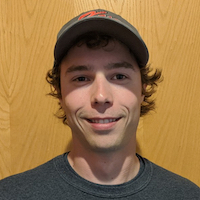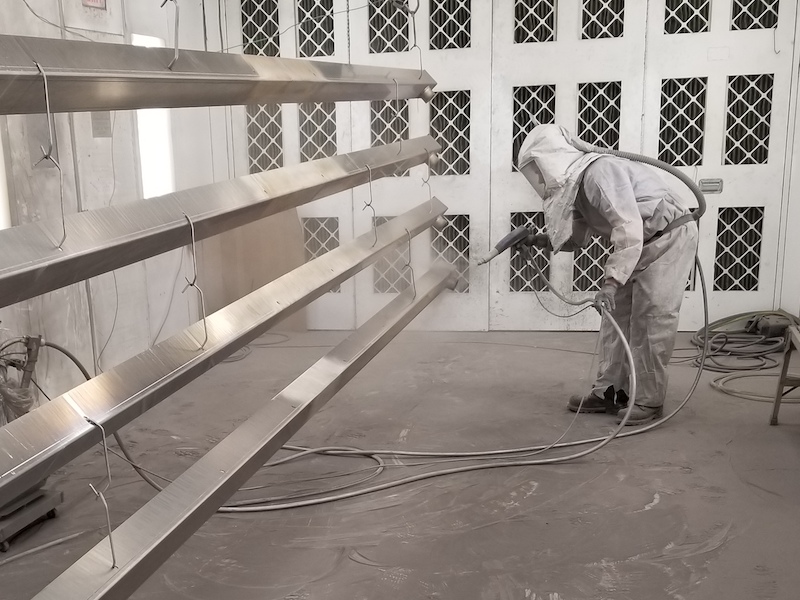Knock on wood, but many powder coating applicators are hoping that the dream of finding a reliable low-cure coating will soon be coming around the corner.
Although several suppliers have introduced products that they say are low cure and can be used on wood, the ability for powder coaters to expand their market into cabinetry, furniture, and other nonmetal fixtures is something they have been waiting for quite a while.
In fact, in a survey of dozens of powder coating applicators across the U.S. by FinishingAndCoating.com, coating on wood and medium-density fiberboard (MDF) was one of the top trends that coaters and finishers were indicating they were keeping a watchful eye on in the future.
1: Wood and MDF: Next Logical Step for Job Shops

 |
 |
|
| Jase Kaser | Rick Gehman |
Powder coating on wood, MDF, and other nonmetal materials seems like the next logical step for job shops like ours that are seeking to expand their services,” says Jase Kaser, General Manager at Kaser Blasting & Coatings in Lincoln, Nebraska.
Richard Gehman, President of Keystone Koating in Pennsylvania, says he continues to hear news about powder coating on wood or alternative substrates and will possibly explore the opportunity in the future.
“We are looking at doing this at some time, but we currently lack space to start,” Gehman says.
Aside from delving into new markets to find customers who need powder coating on wood or MDF, some powder coaters like the idea of low cure powders for cost-saving reasons, too.
2: Generating Faster Speeds and Higher Outputs

 |
 |
|
| Adam Brumfield | Bill Stock |
“We are looking at low-cure powders that allow for faster line speeds and higher outputs,” says Adam Brumfield, Director of Business and Product Development at Roy Metal Finishing in Greenville, South Carolina, which operates a large electroplating, electrocoating and powder coating operation focusing in the automotive, heavy truck and industrial industries.
Bill Stock, President of Microfinish in Truesdale, Missouri, says he is looking forward to utilizing materials with lower cure temperatures to reduce energy usage.
“That will be essential in the future,” he says. “It is not only a cost-saving issue but availability of resources.”
With rolling brownouts and being asked to curtail operations during a peak period of energy usage, Stock says Microfinish is seeking a way to reduce energy to take pressure off the power grid.
“It is increasingly more important,” says Stock, whose company also offers plating and ecoating. “We are already participating in a cooperative effort to reduce the stress on the electrical grid.”
3: Improved Ways to Powder Coat on Aluminum

 Dewain DiaconoAside from low-cure applications, powder coaters that FinishingAndCoating.com surveyed also pointed out several additional trends that they see occurring in the coating industry, including seeing more aluminum parts.
Dewain DiaconoAside from low-cure applications, powder coaters that FinishingAndCoating.com surveyed also pointed out several additional trends that they see occurring in the coating industry, including seeing more aluminum parts.
Dewain Diacono, President of Great Lakes Powder Coating in Walled Lake, Michigan, says many shops are having difficulty pretreating and coating aluminum correctly.
“Are the shops prepping correctly for aluminum? Are they educated to give the end-user a long last product? Are the shops experienced in applying to aluminum?” says Diacono, whose company is also a welding and fabrication operation that works extensively in aluminum substrates.
He says aluminum is one of the more difficult materials to have a powder coat bond, so if the pretreatment and bonding agent is not done right, there will be consequences
“I still hear other coaters just hand washing before powder coat,” Diacono says. “Honestly, these companies should stop coating or be educated. They are making this industry look really bad.”
RMF’s Brumfield says they, too, are doing more lightweight projects with aluminum replacing steel as a substrate.
“Aluminum brings some new challenges,” he says. “There will be different cure rates, line speeds, and also a lack of a rework process, other than chemical strippings.”
4: The Rise of Architectural Coatings

 Ken MartinKen Martin, General Manager of Texas Finishing Company in Carrollton, Texas, says they are witnessing various material trends in the architectural market, including many more aluminum components.
Ken MartinKen Martin, General Manager of Texas Finishing Company in Carrollton, Texas, says they are witnessing various material trends in the architectural market, including many more aluminum components.
“We see sunshades for office buildings, trellises for commercial and residential condos, and perforated panels for a facade or accent on parking garages,” says Martin, whose facility applies coatings in a broad range of colors, including micas and metallics
With sunshade and trellis materials, Martin says it is important for applicators to be aware of prefabricated parts that can be cumbersome to handle in the process. He says some of the issues are tubes with welded endcaps requiring additional curing time and, in some cases, trapping liquid from pretreatment process tanks.
“Also, there is mixed material prefabbed with various metal thicknesses welded together,” Martin says. “This can get tricky trying to cure properly without over baking or underbaking.”
He says applicators also need to be aware of the trend towards perforated panels prefabricated with an attached frame on all sides. During the curing/baking process, Martin says the perforated panel will try to expand with the heat, although the attached frame around it will not allow it.
“This most likely will cause the perforated panel to buckle in the oven and become unusable,” he says. “In order for applicators to be most efficient, profitable, and provide a better product is to apply paint on individual components that are not prefabricated.”
As far as emerging trends, Martin and his team at TMF are seeing requests for wood grain, rustic, and patina look in aluminum panels and extrusions.
“These type of finishes can give architects a more creative edge in design,” he says.
5: Thermoplastic, Nylon, and Anti-Microbial Coatings

 |
 |
|
| Steve Hockett | Kenny Spielman |
Steve Hockett, Vice President of Production at Advanced Industrial Coatings in Stockton, California, says his facility has seen is a bit of an uptick in parts needing a thermoplastic or nylon coating.
AIC recently has started working with a company on cooling coils that would be in larger quantities, and the customer has asked about a conveyor line.
“This is about the third or fourth one like that we have seen – large quantities in nylon for the conveyor,” Hockett says. “It is not easy to do on the conveyor since it is commonly a batch process, and so I think there are a few companies looking for someone to accommodate the large quantity process.”
Kenny Spielman, President of S&B Finishing in Chicago, says the trend their shop is seeing is anti-microbial inquiries had risen. With the COVID pandemic, many shops saw a fast rise in the number of manufacturers asking if those coatings are available.
“The only other trends we’ve noticed is there have been many price increases and some shortages of stock materials,” Spielman says. “We’ve also seen some long lead times on custom products.”
Others to Keep an Eye On
Labor Shortage, Automation and the “Age of Amazon”
Keystone Koating’s Gehman says one of the biggest threats to the coating industry is the continued labor shortage in the U.S. and how facilities may need to automate to help overcome the adversity of not having staff to bring on expansion or new customers.
“I think if labor is going to continue to be a bigger issue, more companies are going to consider automation as part of their production processes,” Gehman says. “It might mean robotics assistance or specialized finishing equipment designed for certain parts.”
Microfinish’s Stock he needs 30 employees immediately.
“The hottest topic is finding enough employees to support our operation,” he says. “The unemployment office is my biggest competition. Right now, you get $17.35 per hour on unemployment. Why work for $14?”
Gehman speculates about what he calls the “Age of Amazon” and what it will do to finishers as customers expect their parts faster than ever.
“I continue to hear more and more about a quick turnaround and how some companies are using technology and software to shorten quoting and order processing,” he says.
Stock concurs that finishers are seeing a requirement from customers on preparing parts in what he calls “ready to ship” packaging, which has shops like Microfinish coating parts and then including additional hardware and other components from their customers into boxes.
“We have to educate ourselves on better packaging materials,” he says. “We do not just need to use materials that will get the product 50 miles to our customers, but making it hold up to longer and multiple shipments, and hold up to UPS and FedEx handling.”
Luckily, Stock says their customers are okay with compensating Microfinish for this service, although he still has to deliver on it and needs labor to pull it off.
“It is service customers are more willing to pay for,” he says. “They are not as price-sensitive as the actual powder coating process.”
Embracing Multi-Layer Coating Processes
RMF’s Brumfield points out that coating facilities will need to be diversify, easier said than done, to offering more than just a powder coating as many customers are starting to request more multi-layer processes.
RMF’s multi-process facility is adding powder coat over zinc and ecoat, as well as the unique combination of all three: zinc, ecoat, and a powder-coated topcoat.
But having such a complex process will require additional software and quoting systems that can capture so many variables.
“You will need to have effective quoting systems in place,” Brumfield says. “It will need to capture surface area, line speed, powder cost , cure temps, pretreatment requirements, powder reclaim or spray to waste and even post-powder packaging requirements.”
Managing Great Expectations
 Dallas CooleyFor Dallas Cooley, Vice President Sales at Georgia Powder Coating, he is seeing a trend of some customers expecting flawless coatings on substrates that are anything but.
Dallas CooleyFor Dallas Cooley, Vice President Sales at Georgia Powder Coating, he is seeing a trend of some customers expecting flawless coatings on substrates that are anything but.
He says that some online direct-to-consumer powder coating suppliers are exhibiting immaculately prepared samples of transparent colors. They look really cool, Cooley says, but they were produced on flawlessly polished panels.
“The issue is the end consumer gravitates to such colors imagining their project glistening with the same consistency, but their material is in less than desirable conditions and odd-shaped,” Cooley says. “That results in inconsistent thicknesses with the powder coating, and that changes the desired color because it’s transparent.”
He says it is an important trend for powder coaters to talk early with customers so they can steer them away from what he calls “allusions of candy land colors.”
“If the material is flawless — and conducive for such a coating — it can be recommended at that time,” Cooley says. “I am not saying there is not a place for such coatings; my concern is they are being present in unrealistic fashions, and that sets the industry up for failure.”



































